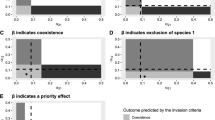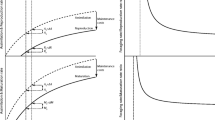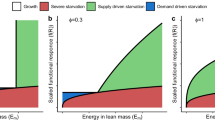Abstract
A difference equation model for the dynamics of a semelparous size-structured species consisting of juvenile and adult individuals is derived and studied. The adult population consists of two size classes, a smaller class and a larger more fertile class. Negative feedback occurs through slowed juvenile growth due to increased total population levels during the developmental period and consequently a smaller adult size at maturation. Intra-specific competition coefficients are size dependent and measure the strength of intra-specific competition between juveniles and adults. It is shown that equilibrium states in which adults and juveniles occur together at all times are in general destabilized by significantly increased juvenilevs adults competition with the result that stable periodic cycles appear, in which the generations alternate in time and hence avoid competition. This result supports the tenet that intra-specific competition between juveniles and adults is destabilizing. Exceptions to this destabilization principle are found, however, in which populations exhibiting non-equilibrium, aperiodic dynamics can be equilibrated by increase competition between juveniles and adults. This occurs, for example, when adult fertility and competition coefficients are significantly size class dependent.
Similar content being viewed by others
Literature
Bellows, T. S. Jr. 1982. Analytical models for laboratory populations ofCallosobruchus chinensis, andC. maculatus (Colioptera, Bruchidae).J. Anim. Ecol. 51, 263–287.
Botsford, L. W. 1981. The effects of increased individual growth rates on depressed population size.Am. Nat. 117, 38–63.
Calder, W. A. 1984.Size, Function, and Life History. Cambridge, Massachusetts: Harvard University Press.
Caswell, H. 1989.Matrix Population Models. Sunderland, MA: Sinauer.
Cushing, J. M. 1992.Some delay models for juvenile vs adult competition. Proceedings of the Claremont Conference on Differential Equations and Applications to Biology and Population Dynamics, Busenberg and Martelli (eds). Berlin: Springer. In press.
Cushing, J. M. 1988. Nonlinear matrix models and population dynamics.Nat. Resources Modeling 2, 539–580.
Cushing, J. M. and Jia Li. 1989. On Ebenman’s model for the dynamics of a population with competing juveniles and adults.Bull. math. Biol. 51, 687–713.
Cushing, J. M. and Jia Li. 1992. Juvenile versus adult competition.J. math. Biol., in press.
Ebenman, B. 1987. Niche differences, between age classes and intraspecific competition in agestructured populations.J. theor. Biol. 124, 25–33.
Ebenman, B. 1988a. Competition between age classes and population dynamics.J. theor. Biol. 131, 389–400.
Ebenman, B. 1988b. Dynamics of age-and size-structured populations: intraspecific competition. InSize-Structured Populations, B. Ebenman and L. Persson (eds), pp. 127–139. Berlin: Springer-Verlag.
Ebenman, B. and L. Persson. 1988.Size-Structured Population: Ecology and Evolution. Berlin: Springer-Verlag.
Guckenheimer, J. and P. Holmes. 1983.Nonlinear Oscillations, Dynamical Systems, and Bifurcations of Vector Fields. New York: Springer Verlag.
Hutchinson, G. E. 1959. Homage to Santa Rosalia or why are there so many kinds of animals.Am. Nat. 93, 145–159.
May, R. M., G. R. Conway, M. P. Hassell and T. R. E. Southwood. 1974. Time delays, density dependence and single-species oscillations.J. Anim. Ecol. 43, 747–770.
Mueller, L. D. 1988. Density-dependent population growth and natural selection in food-limited environments: theDrosophila model.Am. Nat. 132, 786–809.
Murray, J. D. 1989.Mathematical Biology. Biomathematics Texts, Vol. 19. Berlin: Springer.
McNair, J. N. 1989. Stability effects of a juvenile period in age-structured populations.J. theor. Biol. 137, 397–422.
Prout, T. and F. McChesney. 1985. Competition among immatures affects their adult fertility: Population dynamics.Am. Nat. 126, 521–558.
Tschumy, W. O. 1982. Competition between juveniles and adults in age-structured populations.Theor. Popul. Biol. 21, 255–268.
Weiner, J. 1985. Size hierarchies in experimental populations of annual plants.Ecology 66, 743–752.
Werner, E. E. and J. F. Gilliam. 1984. The ontogenetic niche and species interactions in sizestructred populations.Ann. Rev. Ecol. Syst. 15, 393–425.
Wilbur, H. M. 1980. Complex life cycles.Ann. Rev. Ecol. Syst. 11, 67–98.
Author information
Authors and Affiliations
Additional information
The author gratefully acknowledges the support of the Applied Mathematics Division and the Population Biology/Ecology Division of the National Science Foundation under NSF grant No. DMS-8902508.
Research supported by the Department of Energy under contracts W-7405-ENG-36 and KC-07-01-01.
Rights and permissions
About this article
Cite this article
Cushing, J.M., Li, J. Intra-specific competition and density dependent juvenile growth. Bltn Mathcal Biology 54, 503–519 (1992). https://doi.org/10.1007/BF02459632
Received:
Revised:
Issue Date:
DOI: https://doi.org/10.1007/BF02459632




